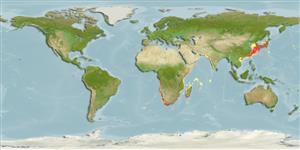Environment: milieu / climate zone / depth range / distribution range
Ökologie
seewasser benthopelagisch; tiefenbereich 20 - 400 m (Ref. 6637). Temperate
Indo-West Pacific: Mozambique and South Africa (Ref. 6637), Japan and the East China Sea. Southeast Atlantic: Cape, South Africa (Ref. 6637).
Size / Gewicht / Alter
Maturity: Lm ? range ? - ? cm
Max length : 150 cm TL Männchen/unbestimmt; (Ref. 559); max. veröff. Gewicht: 16.1 kg (Ref. 40637)
Rückenflossenstacheln (insgesamt): 9 - 10; Rückenflossenweichstrahlen (insgesamt): 13-14; Afterflossenstacheln 3; Afterflossenweichstrahlen: 12 - 13. Adults black in color; juveniles dusky silver.
Adults found in deep rocky areas; young found in shallow water. The diet consists of fishes, crustaceans and squids. Spawns from October to March.
Life cycle and mating behavior
Geschlechtsreife | Fortpflanzung | Ablaichen | Eier | Fecundity | Larven
Heemstra, P.C., 1986. Scombropidae. p. 563. In M.M. Smith and P.C. Heemstra (eds.) Smiths' sea fishes. Springer-Verlag, Berlin. (Ref. 6637)
IUCN Rote Liste Status (Ref. 130435)
Bedrohung für Menschen
Harmless
Nutzung durch Menschen
Mehr Information
NamenSynonymeMetabolismusRäuberÖkotoxikologieFortpflanzungGeschlechtsreifeAblaichenSpawning aggregationFecundityEierEientwicklung
ReferenzenAquakulturAquakultur ProfilZuchtlinienGenetikElectrophoresesVererbbarkeitKrankheitenVerarbeitungNutrientsMass conversion
PartnerBilderStamps, Coins Misc.LauteCiguateraGeschwindigkeitSchwimmstilKiemenoberflächeOtolithsGehirngrößeSehfähigkeit
Tools
Zusatzinformationen
Download XML
Internet Quellen
Estimates based on models
Preferred temperature (Ref.
123201): 10.4 - 22.6, mean 18.2 °C (based on 218 cells).
Phylogenetic diversity index (Ref.
82804): PD
50 = 0.7500 [Uniqueness, from 0.5 = low to 2.0 = high].
Bayesian length-weight: a=0.01072 (0.00415 - 0.02764), b=3.02 (2.80 - 3.24), in cm total length, based on LWR estimates for this (Sub)family-body shape (Ref.
93245).
Trophic level (Ref.
69278): 4.2 ±0.63 se; based on food items.
Generation time: 9.1 ( na - na) years. Estimated as median ln(3)/K based on 1
growth studies.
Widerstandsfähigkeit (Ref.
120179): niedrig, Verdopplung der Population dauert 4,5 - 14 Jahre. (K=0.12).
Fishing Vulnerability (Ref.
59153): High to very high vulnerability (68 of 100).
Nutrients (Ref.
124155): Calcium = 11.6 [7.8, 19.5] mg/100g; Iron = 0.237 [0.154, 0.367] mg/100g; Protein = 18.2 [17.4, 19.0] %; Omega3 = 0.577 [0.350, 0.946] g/100g; Selenium = 24 [13, 44] μg/100g; VitaminA = 18.1 [6.4, 54.7] μg/100g; Zinc = 0.353 [0.275, 0.474] mg/100g (wet weight);
